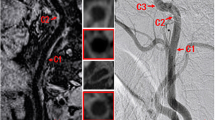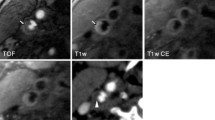Abstract
Purpose
The characterization of atherosclerotic carotid plaque plays a key role in the identification of patients at risk. The aim of our work was to evaluate the potentialities of carotid computed tomography angiography (CCTA) in assessing composition of atherosclerotic plaque.
Materials and methods
We retrospectively evaluated 29 patients (7 women and 22 men, age range 54–81; mean age 69) who underwent carotid endarterectomy. All patients underwent pre-surgical CCTA using a 320-slice scanner. Post-processing reconstructions and analysis were performed using a specific software. Percentage of three different components of the atherosclerotic plaque (adipose, fibrotic and calcific) were classified based on Hounsfield unit values. Post-processing results were compared with histological analysis. Vessel and plaque parameters were compared using the Pearson correlation coefficient (r). Bland–Altman plots with 95% confidence intervals were calculated for correlation. McNemar’s test was used for comparison of dichotomous variables.
Results
A significant correlation between histology and CCTA was found with respect to the areas corresponding to adipose, fibrotic and calcified plaques. The existence of proportional bias was observed between the two quantifying methods with lower discrepancies found for the adipose and fibrotic plaque areas. The Bland–Altman analyses showed a mean bias of 3.2%, 2.5% and 0.6% between histology and CCTA, for adipose, fibrotic and calcified plaque areas, respectively.
Conclusions
Multi-detector CT angiography represents a valuable technique to assess quantitatively the composition of atherosclerotic plaques, with particular reference to the prevalence of fibrotic tissue, and is a useful diagnostic tool to improve risk stratification of patients for cerebral stroke.



Similar content being viewed by others
References
Saba L, Anzidei M, Cavallo Marincola B et al (2014) Imaging of the carotid artery vulnerable plaque. Cardiovasc Intervent Radiol 37(3):572–585
Paonessa A, Limbucci N, Tozzi E, Splendiani A, Gallucci M (2010) Radiological strategy in acute stroke in children. Eur J Radiol 74(1):77–85
Splendiani A, Catalucci A, Limbucci N, Turner M, Krings T, Gallucci M (2012) Pediatric inflammatory diseases. Part III: small vessels vasculitis. Neuroradiol J 25(6):715–724
Fuster V, Badimon L, Badimon JJ, Chesebro JH (1992) The pathogenesis of coronary artery disease and the acute coronary syndromes. N Engl J Med 326(4):242–250
van Rugge FP, van der Wall EE, Spanjersberg SJ, de Roos A et al (1994) Magnetic resonance imaging during dobutamine stress for detection and localization of coronary artery disease. Quantitative wall motion analysis using a modification of the centerline method. Circulation 90(1):127–138
Falk A, Schmieder K, Hentsch A, Harders A, Heuser L (1996) 3-D-tone magnetic resonance angiography in the detection of intracranial aneurysms compared with digital subtraction angiography. A prospective study. Rofo 164(1):31–37
Davis MJ (1996) Stability and instability: two faces of coronary atherosclerosis. The Paul Dudley White Lacture 1995. Circulation 94:2013–2020
Fayad ZA (2001) The assessment of the vulnerable atherosclerotic plaque using MR imaging: a brief review. Int J Cardiovasc Imaging 17(3):165–177
Crisby M, Nordin-Fredriksson G, Shah PK, Yano J, Zhu J, Nilsson J (2001) Prevastatin treatment increases collagen content and decreased lipid content, inflammation metalloproteinases and cell death in human carotid plaques: implication for plaque stabilization. Circulation 103(7):926–933
Gupta A, Mtui EE, Baradaran H et al (2015) CT angiographic features of symptom-producing plaque in moderate-grade carotid artery stenosis. AJNR Am J Neuroradiol 36(2):349–354
Barnett HJ, Taylor DW, Eliasziw M et al (1998) Benefit of carotid endarterectomy in patients with symptomatic moderate or severe stenosis. North American symptomatic carotid endarterectomy trial collaborators. N Engl J Med 339(20):1415–1425
Huibers A, de Borst GJ, Wan S et al (2015) Non-invasive carotid artery imaging to identify the vulnerable plaque: current status and future goals. Eur J Vasc Endovasc Surg 50(5):563–572
Chalela JA (2009) Evaluating the carotid plaque: going beyond stenosis. Cerebrovasc Dis 27(Suppl 1):19–24
Li Q, Zhou Y, Dong K et al (2015) The association between serum uric acid levels and the prevalence of vulnerable atherosclerotic carotid plaque: a cross-sectional study. Sci Rep 5:10003–10009
Brinjikji W, Huston J 3rd, Rabinstein AA et al (2016) Contemporary carotid imaging: from degree of stenosis to plaque vulnerability. J Neurosurg 124(1):27–42
Leipsic J, Abbara S, Achenbach S, Cury R, Earls JP et al (2014) SCCT guidelines for the interpretation and reporting of coronary CT angiography: a report of the society of cardiovascular computed tomography guidelines committee. J Cardiovasc Comput Tomogr 8(5):342–358
Tarkin JM, Dweck MR, Evans NR, Takx RAP, Brown AJ, Tawakol A, Fayad ZA, Rudd JHF (2016) Imaging atherosclerosis. Circ Res 118:750–769
Chopard R, Boussel L, Motreff P et al (2010) How reliable are 40 MHz IVUS and 64-slice MDCT in characterizing coronary plaque composition? An ex vivo study with histopathological comparison. Int J Cardiovasc Imaging 26:373–383
De Weert TT, Ouhlous M, Meijering E et al (2006) In vivo characterization and quantification of atherosclerotic carotid plaque components with multidetector computed tomography and histopathological correlation. Arterioscler Thromb Vasc Biol 26(10):2366–2372
Saba L, Francone M, Bassareo PP, Lai L, Sanfilippo R, Montisci R, Suri JS, De Cecco CN, Faa G (2018) CT attenuation analysis of carotid intraplaque hemorrhage. Am J Neuroradiol 39(1):131–137. https://doi.org/10.3174/ajnr.A5461
Saremi F, Achenbach S (2015) Coronary plaque characterization using CT. Am J Roentgenol 204(3):W249–W260. https://doi.org/10.2214/AJR.14.13760
Obaid DR, Calvert PA, Gopalan D et al (2013) Athero-sclerotic plaque composition and classification identified by coronary computed tomography: assessment of computed tomography-generated plaque maps compared with virtual histology intravascular ultrasound and histology. Circ Cardiovasc Imaging 6:655–664
van Gils MJ, Vukadinovic D, van Dijk AC et al (2012) Carotid atherosclerotic plaque progression and change in plaque composition over time: a 5-year follow-up study using serial CT angiography. AJNR Am J Neuroradiol 33:1267–1273
Rozie S, de Weert TT, de Monyé C et al (2009) Atherosclerotic plaque volume and composition in symptomatic carotid arteries assessed with multidetector CT angiography; relationship with severity of stenosis and cardiovascular risk factors. Eur Radiol 19:2294–2301
Komatsu S, Imai A, Kodama K (2011) Multidetector row computed tomography may accurately estimate plaque vulnerability: does MDCT accurately estimate plaque vulnerability? (Pro). Circ J 75:1515–1521
Kimura S, Yonetsu T, Suzuki K et al (2012) Characterisation of non-calcified coronary plaque by 16-slice multidetector computed tomography: comparison with histopathological specimens obtained by directional coronary atherectomy. Int J Cardiovasc Imaging 28:1749–1762
Di Cesare E, Gennarelli A, Di Sibio A et al (2015) Image quality and radiation dose of single heartbeat 640-slice coronary CT angiography: a comparison between patients with chronic atrial fibrillation and subjects in normal sinus rhythm by propensity analysis. Eur J Radiol 84(4):631–636. https://doi.org/10.1016/j.ejrad.2014.11.035
Nordestgaard BG, Gronholdt ML, Sillesen H et al (2003) Echolucent rupture-prone plaques. Curr Opin Lipidol 14(5):505–512
Sztajzel R (2005) Ultrasonographic assessment of the morphological characteristic of the carotid plaque. Swiss Med Wkly 135(43–44):635–643
Geroulakos G, Ramaswami G, Nicolaides A et al (1993) Characterization of symptomatic and asymptomatic carotid plaques using high-resolution real-time ultrasonography. Br J Surg 80(10):1274–1277
ten Kate GL, van Dijk AC, van der Oord SC et al (2013) Usefulness of contrast-enhanced ultrasound for detection of carotid plaque ulceration in patients with symptomatic carotid atherosclerosis. Am J Cardiol 112(2):292–298
Gupta A, Baradaran H, Schweitzer AD et al (2013) Carotid plaque MRI and stroke risk: a systematic review and meta-analysis. Stroke 44(11):3071–3077
Esposito-Bauer L, Saam T, Ghodrati I et al (2013) MRI plaque imaging detects carotid plaques with a high risk for future cerebrovascular events in asymptomatic patients. PLoS ONE 8(7):e67927
Di Cesare E, Cademartiri F, Carbone I (2012) Clinical indications for cardiac computed tomography. From the Working Group of the Cardiac Radiology Section of the Italian Society of Medical Radiology (SIRM). Radiol Med 117(6):901–938
Wintermark M, Arora S, Tong E et al (2008) Carotid plaque CT imaging in stroke and non stroke patients. Ann Neurol 64(2):149–157
De Weert TT, Cretier S, Groen HC et al (2009) Atherosclerotic plaque surface morphology in the carotid bifurcation assessed with multidetector computed tomography angiography. Stroke 40(4):1334–1340
Homburg PJ, Rozie S, van Gils MJ et al (2011) Association between carotid artery plaque ulceration and plaque composition evaluated with multidetector CT angiography. Stroke 42(2):367–372
Vukadinovic D, Rozie S, van Gils M et al (2012) Automated versus manual segmentation of atherosclerotic carotid plaque and components in CTA: associations with cardiovascular risk factors. Int J Cardiovasc Imaging 28(4):877–887
Acknowledgements
The authors wish to thank Angela Martella for English revision of the manuscript.
Author information
Authors and Affiliations
Corresponding author
Ethics declarations
Conflict of interest
The authors declare that they have no conflict of interest.
Ethical approval
All procedures performed in studies involving human participants were in accordance with the ethical standards of the institutional and/or national research committee and with the 1964 Declaration of Helsinki and its later amendments or comparable ethical standards.
Human and animal rights statement
This article does not contain any studies with animals performed by any of the authors.
Informed consent
Informed consent was obtained from the participants included in the study.
Additional information
Publisher's Note
Springer Nature remains neutral with regard to jurisdictional claims in published maps and institutional affiliations.
Rights and permissions
About this article
Cite this article
Varrassi, M., Sferra, R., Gravina, G.L. et al. Carotid artery plaque characterization with a wide-detector computed tomography using a dedicated post-processing 3D analysis: comparison with histology. Radiol med 124, 795–803 (2019). https://doi.org/10.1007/s11547-019-01026-8
Received:
Accepted:
Published:
Issue Date:
DOI: https://doi.org/10.1007/s11547-019-01026-8




